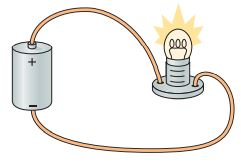2. Consider a lightbulb circuit such as the one in FIGURE Q27.1.
a. From the simple observations and measurements you can make on this circuit, can you distinguish a current composed of positive charge carriers from a current composed of negative charge carriers? If so, describe how you can tell which it is. If not, why not?
b. One model of current is the motion of discrete charged particles. Another model is that current is the flow of a continuous charged fluid. Do simple observations and measurements on this circuit provide evidence in favor of either one of these models? If so, describe how. If not, why not?




